Students rely on Class 6 Maths Extra Questions Chapter 3 Number Play Class 6 Extra Questions and Answers to improve their grades.
Class 6 Maths Chapter 3 Extra Questions Number Play
Class 6 Maths Number Play Extra Questions
NCERT Class 6 Maths Chapter 3 Number Play Extra Questions and Answers
Very Short Answer Type
Question 1.
Mark the supercells in the table given below.
![]()
Answer:
![]()
Question 2.
Fill in the table below with only 3-digit numbers such that the supercells are exactly the circled cell.
![]()
Answer:
![]()
Question 3.
Mark the supercells in the table given below.
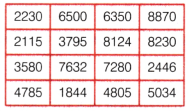
Answer:
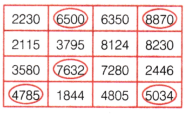
Question 4.
Which one is the greatest number?
(i) 47645, 48740
(ii) 15896, 26760
Answer:
(i) Here, ten thousands digit is 4 in both numbers.
But thousands digit in 47645 is 7 and thousands digit in 48740 is 8. So, 8 > 7.
Hence, 48740 > 47645
(ii) In 15896, ten thousands digit is 1 and ten thousands digit in 26760 is 2. So, 2 > 1.
Hence, 26760 > 15896.
Question 5.
Write the greatest and smallest of the following numbers, 29706, 28706, 39406, 87604.
Answer:
In the given numbers, we see that 28706 is the smallest and 87604 is the greatest.
![]()
Question 6.
Using the digits 3, 5, 4, 6 without repetition, write the smallest four digit number.
Answer:
Here, given digits are 3, 5, 4, 6. For the smallest number, we write the digits in ascending order. So, the smallest four digit number is 3456.
Question 7.
Make the greatest five digit number using the digits 1, 2, 7, 9,4, without repetition.
Answer:
Given, digits are 1, 2, 7, 9, 4.
For greatest number, we write the digits in descending order.
So, the greatest five-digit number is 97421.
Question 8.
What is the first step of the Collatz conjecture for an even number.
Answer:
The first step of the Collatz conjecture for an even number is to divide the number by 2.
Question 9.
What is the smallest four digit palindrome number?
Answer:
Smallest four-digit palindrome number is 1001.
Question 10.
What is the result when you repeately apply the Kaprekar routine to the number 3524?
Answer:
The result is 6174.
Question 11.
What is the sum of the digits in the number 909 and 666?
Answer:
The sum is 9 + 0 + 9 =18, 6 + 6 + 6 = 18
Question 12.
Is 78987 a palindromic number?
Answer:
Yes, 78987 is a palindromic number.
Question 13.
How many numbers are there between 10 and 20 in the pattern increasing by 2? Competency Based Question
Answer:
We have the pattern as 10, 12, 14, 16, 18, 20
Thus, there are four numbers between 10 and 20.
Short Answer Type Questions
Question 1.
Identify the numbers marked on the number lines below, and label the remaining positions.
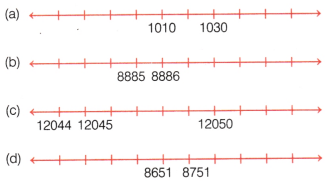
Answer:
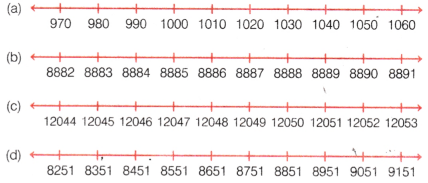
Question 2.
Put a circle around the smallest number and a box around the largest number in each of the above sequences in question 1.
Answer:

![]()
Question 3.
What is the next number in the Collatz sequence after 8?
Answer:
Since, 8 is an even number, the next number in the Collatz sequence will be half of 8 i.e. 4.
Question 4.
If you start with 7, then what is the result of the Collatz Sequence?
Answer:
If we start with 7, the result of the Collatz sequence is
7 → 22 → 11 → 34 → 17 → 52 → 26 → 13 → 40 → 20 → 10 → 5 → 16 → 8 → 4 → 2 → 1.
Question 5.
Use the numbers, 50000, 800, 500, 300 and 1200 to form the number 49800.
Answer:
50000 -1200 – 300 + 800 + 500 = 49800
Question 6.
What is the largest five digit palindrome number?
Answer:
The largest five digit nalindrome number is 99999.
Question 7.
What happens to the number 11 in the Collatz conjecture?
Answer:
Since, 11 is an odd number, we multiply 11 by 3 and then add 1 to it.
i.e. 11 x 3 + 1 = 34
Question 8.
Identify the supercells in the given table.
![]()
Answer:
![]()
Question 9.
Complete the number line given below.
![]()
Answer:
![]()
Question 10.
Write two 3-digit numbers whose digits sum is 20.
Answer:
3-digits numbers whose digit’s sum 20 are 992(9 + 9 + 2 = 20) and 965(9 + 6 + 5 = 20).
![]()
Question 11.
What is the next number in the Collatz sequence after 15?
Answer:
Since, 15 is an odd number.
We multiply 15 by 3 and then add 1 to it. i.e. 15 × 3 + 1 =46
Question 12.
What is the difference largest and smallest four digit number made by using digits 4, 6, 8, 1.
Answer:
Largest Number = 8641
Smallest Number = 1468
Difference = 8641 – 1468 = 7173
Long Answer Type Questions
Question 1.
Mark the supercells in the given table and write the reason behind it.

Answer:

Since, the numbers adjacent to 91827, 71129 and 81290 are smaller, therefore these numbers are supercells.
Question 2.
Choose four digits to make Competency Based Question
(a) the difference between the largest and smallest numbers greater than 4045.
(b) the difference between the largest and smallest number less than 5085.
(c) the sum of the largest and smallest numbers greater than 6556.
(d) the sum of the largest and smallest numbers less than 6556.
Answer:
(a) Largest number = 9999 and smallest number = 4046
Difference = 5953
(b) Largest number = 5084 and smallest number = 1000
Difference = 4084
(c) Largest number = 9999 and smallest number = 6557
Sum = 16556
(d) Largest number = 6555 and smallest = 1000
Sum =7555
Question 3.
Write an example for each of the following scenarios.
(i) 5-digit + 5-digit to give a 5-digit sum more than 50550.
(ii) 5-digit + 5-digit to give 28500.
(iii) 4-digit + 4-digit to give a 5-digit sum.
(iv) 5-digit – 5-digit to give 61600.
(v) 5-digit + 3-digit to give a 6-digit sum.
(vi) 5-digit -4-digit to give 4-digit difference.
(vii) 5-digit -5-digit to give a 3-digit difference.
Answer:
(i) 55000 + 12000=67000
(ii) 17500+11000 = 28500
(iii) 9999+1100=11099
(iv) 99999-38399=61600
(v) 99999+999=100998
(vi) 10000-2000 = 8000
(vii) 90000-89500 = 500
Question 4.
Apply the Kaprekar routine to the number 1225, show each step and verify if the routine leads to Kaprekar! constant.
Answer:

Thus, we obtain Kaprekar’s constant 6174.
Question 5.
What is the sum of the smallest and largest four digit palindrome? What is their difference?
Answer:
Smallest 4-digit palindrome number = 1001
Largest 4-digit palindrome number = 9999
Difference = 9999-1001 = 8998
Sum = 9999 + 1001 = 11000
Question 6.
Identify the pattern in the sequence 2218, 2220, 2222, 2224.
Explain how would you find the next three numbers in the given sequence.
Answer:
In the sequence,
2218, 2220, 2222, 2224,…
The next number is two more than the previous number.
Thus, next three numbers are
2224 + 2 = 2226
2226 + 2 = 2228
2228 + 2 = 2230
![]()
Question 7.
Write an example for the following
(i) 5-digit – 5-digit to give 61500
(ii) 4-digit + 4-digit to give a 5-digit sum
Answer:
(i) The two 5-digit numbers whose difference is
81500 – 20000 = 61500
(ii) 9843 + 1024 = 10867
Question 8.
Show the Collatzsequence starting with number 12.
Answer:
12 (even) → (12/2 = 6)
6 (even) → (6/2 = 3)
3 (odd) → (3 × 3 + 1= 10)
10 (even) →(10 / 2 = 5)
5 (odd) → (5 × 3 + 1 = 16)
16 (even) → (16/2 = 8)
8 (even) → (8/2 = 4)
4 (even) → (4/2 = 2)
2 (even) → (2 / 2 = 1)
So, the Collatz sequence for 12 is 12, 6, 3, 10, 5, 16, 8, 4, 2, 1.
Case Study-based Questions
Question 1.
Sita and Raj are exploring giant number lines in their playground. They start at the number 5 and hopes to different numbers following specific rules. Sita hopes three numbers ahead, while Raj hopes two numbers back.
Based on the above information, answer the following questions.
(i) If Sita starts at 5 and hopes 3 numbers ahead, where does she land?
(ii) If Raj starts at 5 and hopes 2 numbers back, where does he land?
(iii) What is the sum of the numbers where Sita and Raj lands.
Answer:
(i) 5 + 3 = 8
(ii) 5-2 = 3
(iii) 8 + 3 = 11
Question 2.
A student has the digits 5, 5,1, and 2. The task is to form both the smallest and largest four digit numbers using these digits.
Based on the above information, answer the following questions.
(i) What is the smallest number you can form using the digits 5, 5,1, and 2
(ii) What is the largest number you can form using these same digits?
(iii) What is the sum of the largest and the smallest numbers so formed?
(iv) What is the difference between the smallest and the largest numbers so formed?
Answer:
(i) 1255
(ii) 5521
(iii) 1255 + 5521 = 6776
(iv) 5521 – 1255 = 4266
![]()
Question 3.
A teacher shows the students some numbers on the number line. She asks the students to identify the pattern and predict the numbers on the number line.
![]()
Based on the above information, answer the following questions.
(i) What is the pattern in the given number line?
(ii) What is the 6th number on the number line?
(iii) Write down all the numbers on the number line.
Answer:
(i) There is a difference of 1000 between each consecutive numbers.
(ii) 26650
(iii)
![]()
Class 6 Maths Chapter 3 Extra Questions in Hindi संख्याओं का खेल
Number Play Class 6 Extra Questions in Hindi
प्रश्न 1.
निम्नलिखित में से कौन-सी संख्या सारणी [45, 78, 92, 31, 60] में एक महाकोष्ठ है?
(a) 45
(b) 78
(c) 92
(d) 60
हल:
महाकोष्ठ एक सारणी में एक संख्या है जो अपने सभी बराबर की संख्याओं से बड़ी होती है। दी गई सारणी में, 92, 78 (बाईं ओर) और 31 ( दाईं ओर) से बड़ा है, जिससे यह एक महाकोष्ठ बनता है। इसलिए सही उत्तर विकल्प (c) है।
प्रश्न 2.
नीचे दिए गए एक पंक्ति सारणी को देखकर पहचानें कि कौन-से कोष्ठ महाकोष्ठ हैं।
253 421 356 789 345 678 234
हल:
421 एक महाकोष्ठ है क्योंकि यह 253 और 356 से बड़ा है।
789 एक महाकोष्ठ है क्योंकि यह 356 और 345 से बड़ा है।
678 एक महाकोष्ठ है क्योंकि यह 345 और 234 से बड़ा है।
प्रश्न 3.
संख्याओं 2180, 9950, 3050 को संख्या रेखा पर रखने का सही क्रम क्या है?
(a) 2180, 3050, 9950
(b) 3050, 2180, 9950
(c) 9950, 3050, 2180
(d) 2180, 9950, 3050
हल:
संख्याओं 2180, 9950 और 3050 को संख्या रेखा पर बढ़ते क्रम 2180, 3050 और 9950 में रखा जाना चाहिए। इसलिए सही उत्तर विकल्प (a) है।
प्रश्न 4.
नीचे दी गई संख्या रेखाओं पर चिह्नित संख्याओं को पहचानें, और लुप्त संख्याओं को अंकित करें। प्रत्येक अनुक्रम में सबसे छोटी संख्या पर गोला बनाएँ और सबसे बड़ी संख्या पर बॉक्स बनाएँ-


हल:

प्रश्न 5.
अंकों 6382 का प्रयोग करके बनाई जा सकने वाली सबसे बड़ी संख्या क्या है?
(a) 8632
(b) 8362
(c) 8623
(d) 8236
हल:
सबसे बड़ी संख्या बनाने के लिए अंकों को अवरोही क्रम में व्यवस्थित करें। 6382 द्वारा बनाई गई सबसे बड़ी संख्या 8632 है। इसलिए सही उत्तर विकल्प (a) है।
![]()
प्रश्न 6.
1 से 100 तक की सभी संख्याओं को लिखते समय अंक ‘7’ कितनी बार आता है?
(a) 10
(b) 15
(c) 20
(d) 25
हल:
अंक ‘7’ 7वें 17वें 27वें, 37वें, 47वें, 57वें 67वें, 70 – 79 (10 बार) और 87वें 97वें स्थान पर कुल 20 बार आता है। इसलिए सही उत्तर विकल्प (c) है।
प्रश्न 7.
सबसे छोटी 4- अंकों की संख्या क्या है?
(a) 1000
(b) 1001
(c) 1100
(d) 1010
हल:
4 अंकों की सबसे छोटी संख्या 1000 है। अतः सही उत्तर विकल्प (a) है।
प्रश्न 8.
अंकों 5, 9, 2 और 6 में से किसी एक अंक का दो बार उपयोग करने पर सबसे बड़ी 4 अंकों की
संख्या है
(a) 9652
(b) 9562
(c) 9659
(d) 9965
हल:
5 9 2 और 6 में से 9 का दो बार उपयोग करने पर, संख्या 9965 है।
अतः सही उत्तर विकल्प (d) है।
प्रश्न 9.
केवल तीन अलग-अलग अंकों वाली सबसे बड़ी 5-अंकीय संख्या है
(a) 98978
(b) 99897
(c) 99987
(d) 98799
हल:
दिए गए विकल्पों में तीन संख्याएँ 9, 8 और 7 का उपयोग किया गया है। 5-अंकों की सबसे बड़ी संख्या प्राप्त करने के लिए हमें संख्याओं को अवरोही क्रम में व्यवस्थित करना होगा। तब दिए गए विकल्पों में से 5- अंकों की सबसे बड़ी संख्या 99987 है। अतः सही उत्तर विकल्प (c) है।
प्रश्न 10.
4 अंकों वाली संख्याओं की कुल संख्या है-
(a) 8999
(b) 9000
(c) 8000
(d) 9999
हल:
हम जानते हैं कि सबसे छोटी चार अंकों की संख्या = 1,000 और सबसे बड़ी चार अंकों की संख्या = 9,999 है तो चार अंकों की कुल संख्या = (9,999 – 1,000) + 1 = 9,0001
अतः सही उत्तर विकल्प (b) है।
प्रश्न 11.
सत्य या असत्य बताइए।
(a) सबसे बड़ा 6 अंकीय टेलीफोन नंबर जो अंक 5, 3, 4, 7, 0, 8 का केवल एक बार उपयोग करके बनाया जा सकता है, 875403 है।
(b) अंकों 6.7,0,9 में से प्रत्येक अंक का केवल एक बार प्रयोग करके बनाई गई 4 अंकों की सबसे बड़ी संख्या 9760 है।
(c) संख्याएँ 4578, 4587, 5478, 5487 घटते क्रम में है।
हल:
(a) असत्य, सबसे बड़ा 6 अंकीय टेलीफोन नंबर जो अंक 5,3,4,7,0,8 का केवल एक बार उपयोग करके बनाया जा सकता है, 875403 है।
(b) सत्य।
(c) असत्य प्रश्न में, संख्याएँ आरोही क्रम में हैं। दी गई संख्याओं का अवरोही क्रम = 5487, 5478, 4587, 4578
![]()
प्रश्न 12.
अंकों 1, 2 और 3 का उपयोग करके कितनी 3-अंकीय पैलिंड्रोम संख्याएँ बनाई जा सकती हैं?
(a) 2
(b) 4
(c) 6
(d) 8
हल:
अंकों 1, 2 और 3 का उपयोग करके संभावित 3-अंकीय पैलिंड्रोम 121, 131 212 232, 313 और 323 हैं। ऐसी 6 संख्याएँ हैं। इसलिए सही उत्तर विकल्प (c) है।
प्रश्न 13.
निम्नलिखित में से कौन-सी संख्या पैलिंड्रोम है?
(a) 34543
(b) 12321
(c) 65456
(d) 78998
हल:
एक पैलिंड्रोम संख्या आगे और पीछे दोनों तरफ एक समान होती है। दिए गए विकल्पों में से केवल 12321 ही पैलिंड्रोम है।
अतः सही उत्तर विकल्प (b) है।
प्रश्न 14.
दो अंकों वाले सम पैलिंड्रोम लिखिए।
हल:
22, 44, 66, 88
प्रश्न 15.
4 अंकीय संख्याओं के लिए कापरेकर स्थिरांक क्या है?
(a) 495
(b) 6174
(c) 8127
(d) 8372
हलः
4- अंकीय संख्याओं के लिए कापरेकर स्थिरांक 6174 है । अत: सही उत्तर विकल्प (b) है।
प्रश्न 16.
क्या आप कापरेकर की प्रक्रिया का उपयोग उन संख्याओं के साथ कर सकते हैं जो 4-अंकीय संख्याएँ नहीं हैं, जैसे कि 3-अंकीय संख्याएँ? क्यों या क्यों नहीं?
हल:
हाँ, कापरेकर प्रक्रिया विशेष रूप से केवल 4-अंकीय संख्याओं और 3-अंकीय संख्याओं के साथ काम करती है।
यदि आप 5-अंकों या उससे अधिक की संख्याओं का उपयोग करते हैं, तो चरण और स्थिरांक समान नहीं होंगे।
यह प्रक्रिया 4-अंकों की संख्याओं के साथ 6174 और 3-अंकों की संख्याओं के साथ 495 तक पहुँचने के लिए बनायी की गई है।
प्रश्न 17.
अगर आप संख्या 2222 से शुरू करें तो आपको क्या प्राप्त होगा
हल:
यदि आप 2222 से शुरू करते हैं, तो सभी अंक समान होंगे। संख्या को स्वयं से घटाने पर 2222 – 2222 = 0 प्राप्त होता है।
चूँकि कापरेकर की प्रक्रिया में अलग-अलग अंकों की आवश्यकता होती है, इसलिए यह इस संख्या से 6174 तक नहीं पहुँच सकता।
प्रश्न 18.
12 घंटे की डिजिटल घड़ी में, दो समयों के बीच सबसे छोटा अंतराल क्या है जो पैलिंड्रोम हैं (एक ही संख्या के रूप में आगे और पीछे पढ़ा जा सकता है)?
हल:
सबसे छोटा अंतराल दो मिनट का है (9 : 59 और 10 : 01 के बीच का)।
प्रश्न 19.
12 घंटे के चक्र में सभी पैलिंड्रोमिक समयों की सूची बनाएँ।
हल:
- 01 : 10
- 02 : 20
- 03 : 30
- 04 : 40
- 05 : 50
- 10 : 01
- 11 : 11
- 12 : 21
प्रश्न 20.
21वीं सदी में घटित कुछ पैलिंड्रोमिक तिथियाँ कौन-सी हैं?
हल:
02/02/2020, 12/02/2021, 22/02/2022
![]()
प्रश्न 21.
निम्नलिखित में से संख्या 176 के अंकों का सही योग कौन-सा है?
(a) 12
(b) 14
(c) 16
(d) 17
हल:
176 के अंकों का योग 1 + 7 + 6 = 14 है। अतः सही उत्तर विकल्प (b) है।
प्रश्न 22.
87 + 46 को मानसिक रूप से हल करें।
हल:
इसे मन में तोड़ें 87 + 40 = 127,
फिर 6 जोड़ें 127 + 6 = 133
प्रश्न 23.
76 – 34 को मानसिक रूप से हल करें।
हल:
मन में 76 में से 30 घटाएँ, 76 – 30 = 46, शेष 4 घटाएँ = 46 – 4 = 42
प्रश्न 24.
डॉट (●) पैटर्न का उपयोग करके, निम्नलिखित में से कौन-सी संख्या को तीनों प्रकार से व्यवस्थित
किया जा सकता है यानी एक रेखा, एक त्रिकोण और एक आयत?
हल:

प्रश्न 25.
संख्या पैटर्न को समझकर पथ में खाली संख्याओं को भरें।
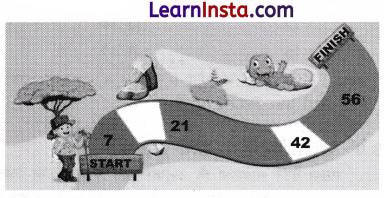
हल:
7, 14, 21, 28, 35, 42, 49, 56, 63
प्रश्न 26.
संख्या 12 से शुरू करें। कोलाट्ज नियमों का पालन करते हुए बताइए 1 तक पहुँचने में कितने चरण लगेंगे।
हलः
समाधान के चरण-
- 12 सम संख्या है, इसलिए 2 से भाग देने पर → 6
- 6 सम संख्या है, इसलिए 2 से भाग देने पर → 3
- 3 विषम है, इसलिए 3 से गुणा करें और जोड़ें → 10
- 10 सम है, इसलिए 2 से भाग देने पर → 5
- 5 विषम है, इसलिए 3 से गुणा करें और 1 जोड़ें → 16
- 16 सम संख्या है, इसलिए इसे 2 से भाग देने पर → 8
- 8 सम संख्या है, इसलिए 2 से भाग दें → 4
- 4 सम है, इसलिए 2 से भाग देने पर → 2
- 2 सम है, इसलिए 2 से भाग देने पर → 1
1 तक पहुँचने में 9 चरण लगते हैं।
![]()
प्रश्न 27.
विभिन्न अंकों वाली सबसे छोटी 4- अंकीय संख्या बताइए।
हल:
विभिन्न अंकों वाली सबसे छोटी 4 अंकीय संख्या 1023 है। यह संख्या चार अंकों की होने और प्रत्येक अंक अद्वितीय होने की दी गई शर्तों को संतुष्ट करती है।
प्रश्न 28.
अंक 7, 1, 0, 5 में से प्रत्येक का केवल एक बार प्रयोग करके सबसे बड़ी और सबसे छोटी 4 अंकों की संख्याएँ बनाइए।
हल:
सबसे बड़ी 4-अंकों की संख्या = 7510। सबसे छोटी 4-अंकों की संख्या = 1057। इसलिए, अंक 7, 1, 0, 5 में से प्रत्येक का केवल एक बार उपयोग करके सबसे बड़ी और सबसे छोटी 4 अंकों की संख्याएँ 7510 और 1057 है।
प्रश्न 29.
अद्वितीय अंकों वाली सबसे बड़ी 5 अंकों की संख्या कौन-सी है?
हल:
98765 अद्वितीय अंकों वाली सबसे बड़ी 5 अंकों की संख्या है।
प्रश्न 30.
यदि आप कोई भी 4-अंकों की संख्या (जहाँ सभी अंक समान नहीं हैं) चुनें, अंकों को फिर से व्यवस्थित करके सबसे बड़ी और सबसे छोटी संख्या बनाएँ, बड़ी संख्या में से छोटी संख्या घटाएँ और प्रक्रिया को दोहराएँ, तो क्या होगा? अंत में आपको हमेशा कौन-सी संख्या मिलती है?
हल:
आप हमेशा 6174 पर पहुँचेंगे जो कि कापरेकर स्थिरांक है।
प्रश्न 31.
कापरेकर स्थिरांक की गणना करते समय यह क्यों महत्त्वपूर्ण है कि 4 अंकों की संख्या के सभी अंक समान न हों?
हल:
यदि सभी अंक समान है (जैसे 1111 या 2222 ), तो संख्या को स्वयं से घटाने पर आपको हमेशा 0 प्राप्त होगा, और आप 6174 तक नहीं पहुँच पाएँगे।
प्रश्न 32.
1 से 7 तक की संख्याओं का उपयोग करके एक सारणी बनाएँ ताकि कोई भी कोष्ठ महाकोष्ठ न हो।
हल:
इस व्यवस्था में कोई भी कोष्ठ अपने निकटतम पड़ोसियों से बड़ा नहीं है- 1 2 3 4 5 6 7।
प्रश्न 33.
अंक 3, 0, 4, 1 से बनने वाली सबसे छोटी 4- अंकों की संख्या है…..
हल:
1034
प्रश्न 34.
अंक 0, 8, 1, 9 से बनने वाली सबसे बड़ी 4 अंकों की संख्या है…..
हल:
9810
![]()
प्रश्न 35.
सत्य के लिए T और असत्य के लिए F लिखें।
(i) 8439 एक विषम संख्या है।
(ii) 2787 एक सम संख्या है।
हल:
(i) सत्य
(ii) असत्य
प्रश्न 36.
अंक 8,0,7,9 का उपयोग करके बनाई जा सकने वाली सबसे बड़ी और सबसे छोटी 4- अंकों की संख्या के बीच क्या अंतर है?
हल:
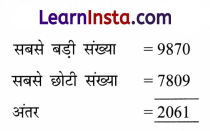
प्रश्न 37.
अंक 7, 1, 8, 3 से बनी सबसे बड़ी संख्या है।
हल:
8731
प्रश्न 38.
अंक 3, 9,0, 1 से बनी सबसे छोटी संख्या है।
हल:
1039
प्रश्न 39.
सबसे छोटी 4 अंकों की सम संख्या है
हल:
1000
प्रश्न 40.
सबसे बड़ी 4 अंकों की सम संख्या है…..
हल:
9998
प्रश्न 41.
नीचे दी गई संख्या रेखाओं पर अंकित संख्याओं को पहचानें और लुप्त संख्याओं को लिखें। नीचे दिए गए प्रत्येक क्रम में सबसे छोटी संख्या के चारों ओर एक वृत्त और सबसे बड़ी संख्या के चारों ओर एक बॉक्स बनाएँ।

हल:

![]()
प्रश्न 42.
सबसे छोटी 2 अंकों की संख्या क्या है जिसके अंकों का योग 9 है?
हल:
18
प्रश्न 43.
क्या संख्या 45654 एक पैलिंड्रोम है? बताइए क्यों या क्यों नहीं?
हल:
45654 एक पैलिंड्रोम है क्योंकि यह पीछे और आगे एक जैसा पढ़ा जाता है।
प्रश्न 44.
12, 23, 34, 45, 56 श्रृंखला में संख्याओं के अंकों का योग निकालें। परिणाम में किसी भी पैटर्न को देखें।
हल:
- 12 : 1 + 2 = 3
- 23 : 2 + 3 = 5
- 34 : 3 + 4 = 7
- 56 : 5 + 6 = 11
- 45 : 4 + 5 = 9
श्रृंखला बढ़ती हुई विषम संख्याओं को दर्शाती है।